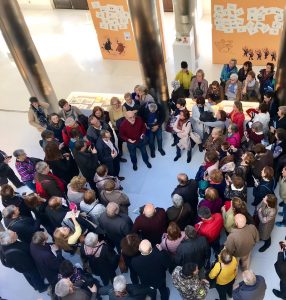
10,435 people have enjoyed the creations of the Valencian illustrator during the two months that the exhibition lasted.
The exhibition, located in the clock building of the Port of Valencia, has been open to the public from December 21st to March the 3rd.
València, March the 7th 2019.- The exhibition “Ortifus, al Mar-intim” located in the Clock Building closed its doors last Sunday with a record number of visitors. In the more than two months that it has remained open to the public, it has received 10,435 visits. The good reception of the exhibition has led the Port Authority of Valencia to consider carrying out a sample of similar characteristics on the same dates of next year with the collaboration of another graphic artist. The PAV will also permanently install some pieces of the Ortifus exhibition, just as it has been doing with the samples that the Clock Building has previously hosted.
Antonio Ortiz Fuster, better known as Ortifus and author of the exhibition recognizes that “it has been a total honor that the Port Authority of Valencia has thought about making an exhibition of the work developed by a graphic humorist. I consider it as a recognition to almost 40 years of work doing criticism with humor”. Regarding the reception of the sample, has moved that “it is a great satisfaction because the sample is not located in a central space, so visitors had to travel to see it and, therefore, we never thought it could reach so much people, all the initial forecasts have been exceeded”.
He also notes that the exhibition has been an opportunity for him “my work is well known, but I did not know the public personally. The exhibition has given me the opportunity to share opinions in a personal way with people and large groups have been organized to visit it together. We started in a modest way and we ended up having practically 3 and 4 groups of more than 40 people. I have spent many hours there attending to the visitors, but I have done it with pleasure because I have felt very grateful”.
For its part, Esther Medán, historian and curator of the exhibition, said that “the objective of the exhibition has been met and exceeded”. Medán has also pointed out the generosity of Ortifus by approaching the Clock building on numerous occasions, where the exhibition has been located, to explain to the visitors some details of his graphic work and respond to the curiosities of the public. “The success of the exhibition has been the grateful work of Ortifus, which is an attractive and critical graphic humor but that does not hurt sensitivities and leaves a very good taste in the mouth”, points out the Valencian historian. In fact, Medán has highlighted the amount of laughter and laughter that was heard in the rooms, giving all the merit to the Valencian ilustrator.
The public that has entered the exhibition is very diverse. Among some groups, there are multiple educational centers: IES del Grau, IES Baleares, IES Rascanya, Luís Vives School (Artistic Baccalaureate), San Pedro School, Pureza de María School and Lyceum French de Lyon, the Labor University and the Popular University. Associations such as ACOVA (Association of people with mental illness in the Valencian Community), Association “Bona Gent” (friends of people with intellectual disabilities), Worker’s Commissions, Group of singles “See you”, have also participated in the exhibition. private group of students of Tourism and the Association of neighbors of Albalat de Sorell. Neighbors from the capital of Turia and tourists from the beach and the dock have taken the opportunity to see the vignettes of the Valencian author.
The Valencian historian notes that the exhibition has recorded hundreds of visits as a family, since the theme is very “happy and festive”. In addition, a children’s area has been set up for the youngest members of the household, where “children have been able to enter the cultural world of exhibitions in an attractive and appropriate way to their age”. This children’s entertainment area had a large panel where Ortifus graphically recreated the professions related to the maritime sector and children could copy these images or paint them. “Since the exhibition was prepared, there was a didactic and versatile approach in the background”, as Madón declares.
The diversity of tools used to create “Ortifus, al Mar-intim” is another key element. Along with the illustrations, books, six small flaws, two prize figures, two fault models, ninots and audiovisual resources have also been exhibited. The role played by the guides stands out, as Medán indicates, “they have adapted their speech, explanation and language to the visiting public so that the exhibition was accessible”.

